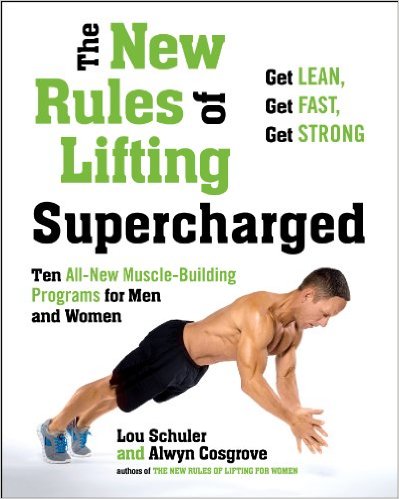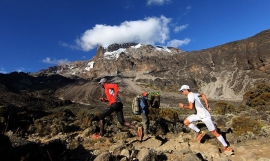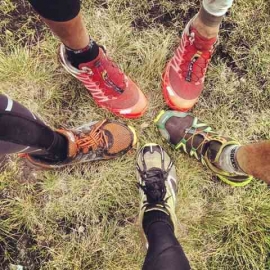This supercharged new edition of The New Rules of Lifting features all-new workouts to build maximum muscle in both men and women.
Lou Schuler and Alwyn Cosgrove’s The New Rules of Lifting, The New Rules of Lifting for Women, and The New Rules of Lifting for Abs have revolutionized how people lift weights. The New Rules of Lifting Supercharged is a total reboot of the weightlifting workout book that launched the series in 2006, packing even more power on every page.
Featuring ten completely new workouts for both women and men, Superchargedemphasizes four major movements that do the most to change the way your body looks, feels, and performs: squat, deadlift, push, and pull. In addition, Cosgrove’s updated total-body workout program improves core strength, mobility, flexibility, balance, endurance, and athleticism . . . all in just three hours a week of exercise.
Another big change from the original New Rules of Lifting is a self-customized workout system. Readers can choose their own exercises from a menu for each movement category, allowing beginner and advanced lifters to get tremendous results from the same basic plan. Each workout ends with a “finisher”—five to ten minutes of fun but high-effort drills such as complexes, intervals, and density training, with the choice of the reader’s favorite exercises. The ultimate guide to total-body strengthening, this supercharged edition of The New Rules of Lifting will lift readers to stratospheric results.
Editorial Reviews
About the Author
Lou Schuler is a National Magazine Award–winning journalist, a certified strength and conditioning specialist, and the author of many top-selling fitness books. He lives in Allentown, Pennsylvania.
Alwyn Cosgrove is a veteran trainer and strength coach. He co-owns Results Fitness in Newhall, California.
Excerpt. © Reprinted by permission. All rights reserved.
In the beginning, Alwyn Cosgrove and I wrote a book called The New Rules of Lifting. And it was good. Readers liked it, and they got outstanding results from Alwyn’s training programs. You wouldn’t be reading the fifth book in the series if the first one hadn’t helped lifters like you reach your goals.
But here’s the thing: Most lifters like you haven’t heard of Alwyn, or me, or the NROL series. Millions of men and women lift weights, either at home or in commercial gyms, but it’s hard to see much evidence to suggest they’re getting what they want from it, or what they could get from it.
Instead, I see all the same behaviors and practices that inspired us to launch the series in the first place.
I see paunchy middle-aged men block the dumbbell rack as they grind through set after set of every biceps exercise they remember from Flex magazine circa 1995, while avoiding the exercises that use the body’s biggest muscles in coordinated action, the movements that would do the most to build muscle, burn fat, and turn back the clock to the days when they looked more like a page from Men’s Health than Cigar Aficionado.
I see apparently healthy women doing the beneficial exercises the men avoid—the squats, deadlifts, and rows—but with weights that wouldn’t challenge someone twice their age, with half their strength.
I see young lifters doing exercises that will turn them into old lifters, the moves most likely to cause injury and least likely to offer much benefit. I see older lifters doing half-baked versions of programs designed for young athletes or bodybuilders, only without any apparent sense of the mechanisms that would make such a program work.
It’s like they’ve all gotten the first half of the memo about the importance of strength training for health, fitness, and appearance. But somehow the rest of the memo—the part that explains what you need to do to get the results you want—got deleted. So, in a way, the NROL series is the second half of that memo.
Take the first New Rule of Lifting: “The best muscle-building exercises are the ones that use your muscles the way they’re designed to work.”
Or the third: “To build size, you must build strength.”
Or the twenty-third: “Results come from hard work.”
Or the forty-third: “You can’t protect your spine by doing exercises that damage it.”
Or the sixty-third: “You’re not a kid anymore. Don’t train like one.”
See what I mean?
The readers who found and implemented the original New Rules of Lifting (along with the ones who read NROL for Women, for Abs, and for Life) know what it means totrain. They know how to lift in a way that allows them to get progressively stronger, to add more muscle, to reduce fat, to work with their bodies rather than againstthem. They’re the ones who walk past the machines in their health club and pick up free weights. They’re the ones who get stronger over time, at any age, despite roadblocks or limitations. They’re the ones who look like they know what they’re doing. They move with purpose. They sweat, they grimace, and every now and then they actually grunt.
Does that describe you?
If so, great. You’re either a satisfied NROL reader, coming back for the newest information and most up-to-date programs, or you’re a target reader, someone who’s ready to do what it takes to get leaner, stronger, and more athletic.
Not you? Pull up a chair, and let’s talk.
Customer Reviews
Just read the core of this book and I am now sketching out plans on how I am going to take it into the gym. As a fan of the original New Rules of Lifting, I think this is a very nice face lift. The main changes that I've noticed from the original is that many of the "why" questions that weren't addressed have been tackled now. Lou Schuler goes into the specifics about why things work and tries to convince you why it would be beneficial to follow these programs.
In the the original NROL, the reader was given lots of workouts that addressed your goals. In this refresh, the reader now has the ability to customize workouts to a much greater degree. Instead of being told "do a Bulgarian Split-Squat" for example, you can now choose to select from a group of exercises that you feel would be best suited for you, and incorporate that into your workout. Different exercises are ranked by varying difficulties, so you know what you're getting into.
Another change I like is that there is now a very detailed section about warm-up and cool-down. In the previous version, I was always at a loss about how to begin and end my workouts. This gives me a nice structure for developing my training regiment.
While I haven't yet tried out the new workouts presented here (but will do so in the next couple trips to the gym), I have great hopes for them. I will post an update after putting them to use. I loved the original NROL because it got me moving and working in a way that made a lot of sense. Instead of simply using the machines and doing bicep curls, the original book got me doing more work that really targeted my body as a whole and were much more effective and efficient than anything else I've tried. I'm looking forward to continuing to be the guy doing deadlifts and squats while everyone else in the weight room are doing curls, and having much better results.
As a guy who lost 15% of my body fat using the original NROL, I'm really happy with this book. I was a little skeptical at first, since I didn't know what they could address that wasn't in the first book, but I really did find a lot of value in this version.
This book is great for those who want to do strength training, but get utterly confused or intimidated when they walk into the free weights section of their gym.
~~~~~~~~~~~~~~~~~~~~~~~~
UPDATE: February 2013
~~~~~~~~~~~~~~~~~~~~~~~~
So I've just completed the first program in this book "Basic Training I" and this evening I'm going to do my first workout in the "Basic Training II" series. My experience so far has been very good. I find that following the program gives me a decent total body fitness routine that leaves my heart pumping and the sweat dripping. My one criticism so far is that using this book is very time-consuming. Designing my first program, with selecting my own exercises, took about 45 minutes. Then after the first week, I had to make some adjustments to which exercises I was using. It probably wasn't until the third or fourth session that I felt like I had a routine that fit me well. Each workout also takes me a little over a hour in the gym to complete, so if you're short on time, I could definitely see that you won't get through everything you planned. Finally, two last minor criticisms are that I feel that the part of the programs dedicated to pure core training is a little sparse, but I adjusted by adding one or two extra exercises during my routine to that section. I also tried one of the variations recommended in the book, an exercise I've never done before, and ending up tweaking my knee a little bit performing "Cross Over Step Ups". Knee tendons were sore for about a week, and I haven't done the cross-over variation since. Live and Learn.
Overall, I remain happy with this book, and maintain the 4* rating. I feel like I can definitely get solid workouts with these programs that are more geared towards my goals (higher-intensity exercise to lose fat, get leaner, and maintain muscle). They are fun, and the fact that you select your own exercises makes you feel like you have more control in your gym time. As a final note about the time-commitment, When I was planning my "Basic Training II" workouts, it took only about 15 min to map out everything since I was more experienced using the book.
I still recommend this book if you are looking to get started in a new effective strength training regiment.




